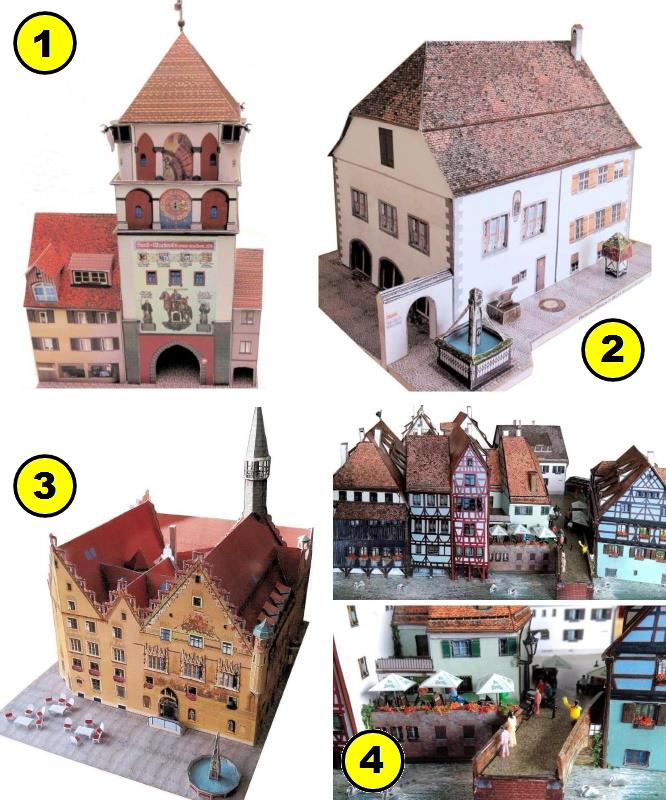This beautiful paper model representing the Chapel of Saint Leonard consists of 151 pieces distributed across five printed sheets.
Perfect for dioramas, RPGs, and wargames, the model of the Chapel of Saint Leonard was created by German designer and model maker Dieter Welz from the Ausschneide Bogen website and is in N scale (1/160).
For a more refined finish, Mr. Welz recommends printing the templates on 160 gsm paper.
The Chapel of Saint Leonard (St.-Leonhards-Kapelle) is located in the Söflingen district of Ulm, Germany.
Consecrated in 1490, its construction may be even older, as it originally served as the parish church of the village.
The chapel is dedicated to Saint Leonard, the patron saint of prisoners, the sick, and domestic animals.
One of the most remarkable elements of the chapel is the painting of the high altar, created in 1754 by Söflingen painter Johann Baptist Enderle. This work depicts Saint Leonard exercising his protective role over those who seek his aid.
Another significant feature is the mural on the chapel’s north side, restored to its original form in 1950 by artist Josef Braun from Wangen/Allgäu.
The chapel features elements of Gothic architecture and houses frescoes and sacred artworks of great historical value.
Söflingen, the district where it is located, is a charming area of Ulm known for its old monastery and picturesque atmosphere.
The Ulm-Söflingen tram circuit provides easy access to this and other local attractions, making the chapel a point of interest for both the faithful and lovers of history and art.
Interestingly, Saint Leonard was widely venerated in the Middle Ages, especially by peasants and prisoners who believed in his power of liberation. His devotion was so strong that many churches and chapels were dedicated to him throughout Europe.
Furthermore, the Chapel of Saint Leonard in Söflingen has withstood the test of time, preserving its spiritual and artistic significance in the Ulm region.
My thanks to my friend Jo Kizinger from the USA for this wonderful find.
Este belo modelo de papel que representa a Capela de São Leonardo é composto por 151 peças distribuídas em cinco folhas impressas.
Perfeito para dioramas, RPG e wargames, o modelo da Capela de São Leonardo foi criado pelo designer e modelista alemão Dieter Welz, do site Ausschneide Bogen, e está na escala N (1/160).
Para um acabamento mais refinado, o Sr. Welz recomenda a impressão dos templates em folhas com gramatura 160.
A Capela de São Leonardo (St.-Leonhards-Kapelle) está localizada no bairro de Söflingen, em Ulm, Alemanha. Consagrada em 1490, sua construção pode ser ainda mais antiga, pois originalmente servia como igreja paroquial da aldeia.
A capela é dedicada a São Leonardo, padroeiro dos prisioneiros, dos doentes e dos animais domésticos.
Um dos elementos mais notáveis da capela é a pintura do altar-mor, realizada em 1754 pelo pintor de Söflingen Johann Baptist Enderle. Essa obra retrata São Leonardo exercendo sua função protetora sobre aqueles que a ele recorrem.
Outra característica importante é o mural situado no lado norte da capela, que foi restaurado em sua forma original em 1950 pelo artista Josef Braun, de Wangen/Allgäu.
A capela apresenta elementos da arquitetura gótica e abriga afrescos e obras de arte sacra de grande valor histórico.
Söflingen, o bairro onde está situada, é uma região charmosa de Ulm, conhecida por seu antigo mosteiro e pelo ambiente pitoresco.
O circuito de bonde de Ulm-Söflingen facilita o acesso a essa e outras atrações locais, tornando a capela um ponto de interesse tanto para fiéis quanto para apreciadores de história e arte.
Curiosamente, São Leonardo foi amplamente venerado na Idade Média, especialmente por camponeses e prisioneiros que acreditavam em seu poder de libertação. Sua devoção era tão forte que muitas igrejas e capelas foram dedicadas a ele em diversas regiões da Europa.
Além disso, a Capela de São Leonardo em Söflingen resistiu ao longo dos séculos, preservando sua importância espiritual e artística na região de Ulm.
Meus agradecimentos ao meu amigo Jo Kizinger, dos EUA, por este belo achado.






























